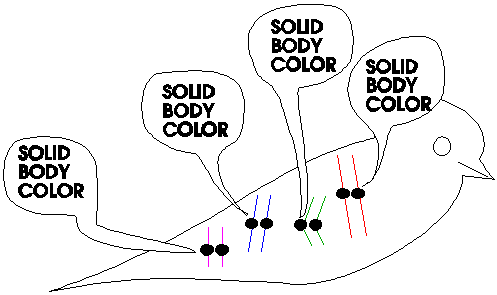
How do budgies manage to have both dominant and recessive pieds? Well, there is more than one gene, on more than one chromosome, that determines the solidness of the color:

The dominant and recessive pied genes in budgies are totally separate. On different sets of chromosomes. If there is a recessive pied gene in a bird, it will always show up on the same pair of chromosomes. In the picture below, I have colored that pair red. I have colored the other pair of chromosomes blue. The blue ones are where the dominant pied gene will always show up, if that bird has a dominant gene.
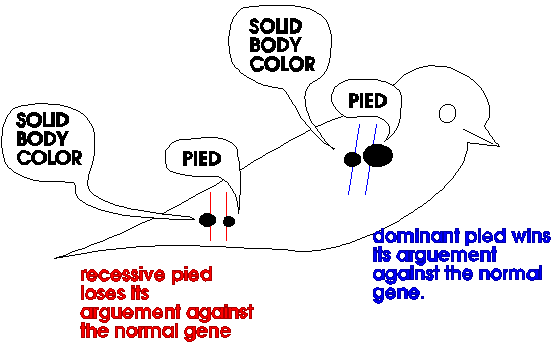
A budgie can have dominant pied genes and recessive pied genes all at the same time. If you haven't done so, you should check out page one of the Educational Budgie Pix to see the differences between the way dominant and recessive pieds look.
(NOTE: I've tried to simplify it here. There are actually several different dominant pieds. They do the same type of arguing on several different chromosomes, and a budgie could have several at once. It would be like saying the one type of dominant gene shows up on the blue chromosomes, another type shows up on the green chromosomes, and another shows up on the purple chromosomes. But let's not try to think about all that now.)
If a budgie has one dominant pied gene, it will look pied.
If a budgie has a pair of dominant pied genes, it will look pied.
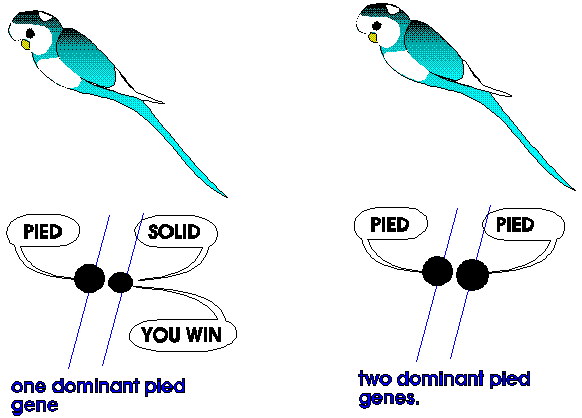
So you can't tell just by looking whether a dominant pied bird has one or two dominant pied genes.
If a budgie has one recessive pied gene, it will look normal (with the exception of the "split to pied spot" on it's head)

If a budgie has two recessive pied genes, it will look pied.
What if a budgie has TWO recessive pied genes and ONE OR TWO dominant pied genes? It will be a dark-eyed clear (white or yellow bird with black eyes). It's like all those pied genes add up and mottle the bird all the way to clear! (Note: some dark eyed clears do have a bit of color on their rump or abdomen.)
What's that you say? You think it's time for a real-life example? Sure! I love dark eyed clears. I own one right now, a white male. I knew his parents, and I know he has only one dominant pied gene. I want more dark eyed clears! What should I breed him with?
Let's look at what Poppa has, genewise: In order to be a clear, he has to have two recessive pied genes, and I said I know he has only one dominant pied gene:
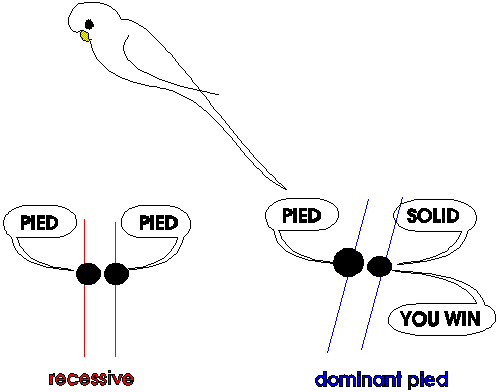
He has two recessive pied genes on that red chromosome. So no matter which of the pair he gives to his kids, he always gives a recessive pied gene.
He has one dominant pied gene and one normal gene paired with it. So he might give a dominant pied gene, or he might give a normal gene from the blue chromosome pair. This means there are only two combinations that he can give: one recessive pied gene with one dominant pied gene, or one recessive pied gene with one normal gene.
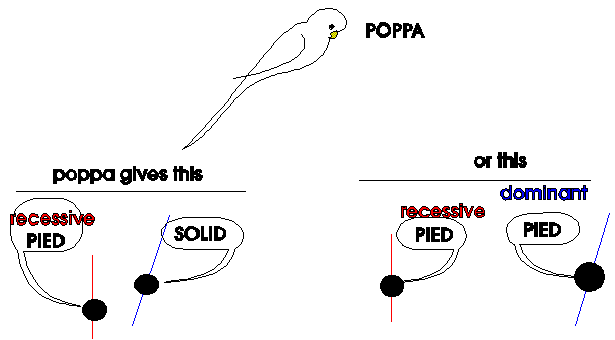
If he gives one recessive and one dominant pied gene, he needs Momma to give a recessive gene in order to make a clear baby. If he gives one recessive and one normal, he needs Momma to give a recessive and a dominant pied gene to make a clear baby. So if he is going to have any clear babies at all, Momma has to have at least one recessive pied gene on those red chromosomes. That is the absolute minimum she can be and still let them make clear babies; she must be at least split to recessive pied. If she had two recessive pied genes, they could make clear babies more often. It would be even better if she could also give a dominant pied gene.
So I'm looking for a hen who is at least split to recessive pied. A recessive pied hen with two recessive pied genes would be better. A clear hen would be even better, because then we'd have a chance to get the dominant pied gene Poppa sometimes doesn't provide. If the hen were clear with two dominant pied genes, we'd get all clear babies all the time.

These genes all occur at exactly the same place, on one set of chromosomes. Kind of the opposite of the pied genes, in a way.
But we know that there are only a pair of genes at any one position! So how can four genes all sit there at once? They can't. A bird still only gets a pair of them. But whichever ones show up, be they normal genes, greywing, clearwing or dilute genes, they show up in the exact same spot. The point is, whichever of these four types is present, they will interact (argue).
Whew! How can we tell who is going to win the arguement, if we have four possible choices? The answer is not simple. It goes like this:
1. Normal always wins if it is present (it's a bully).
OK, let's sum up the genes and how they interact.
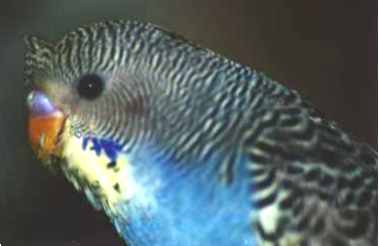
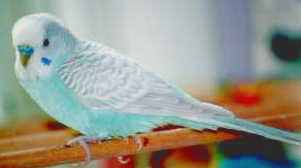
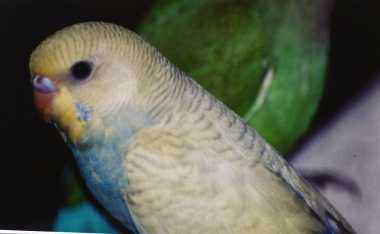
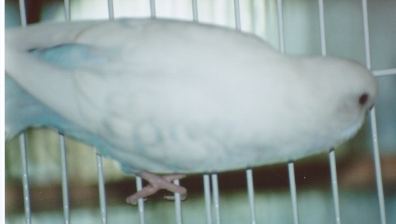
2. Dilute always loses if something else is present(it's a wimp).
3. Greywing and Clearwing compromise with each other.




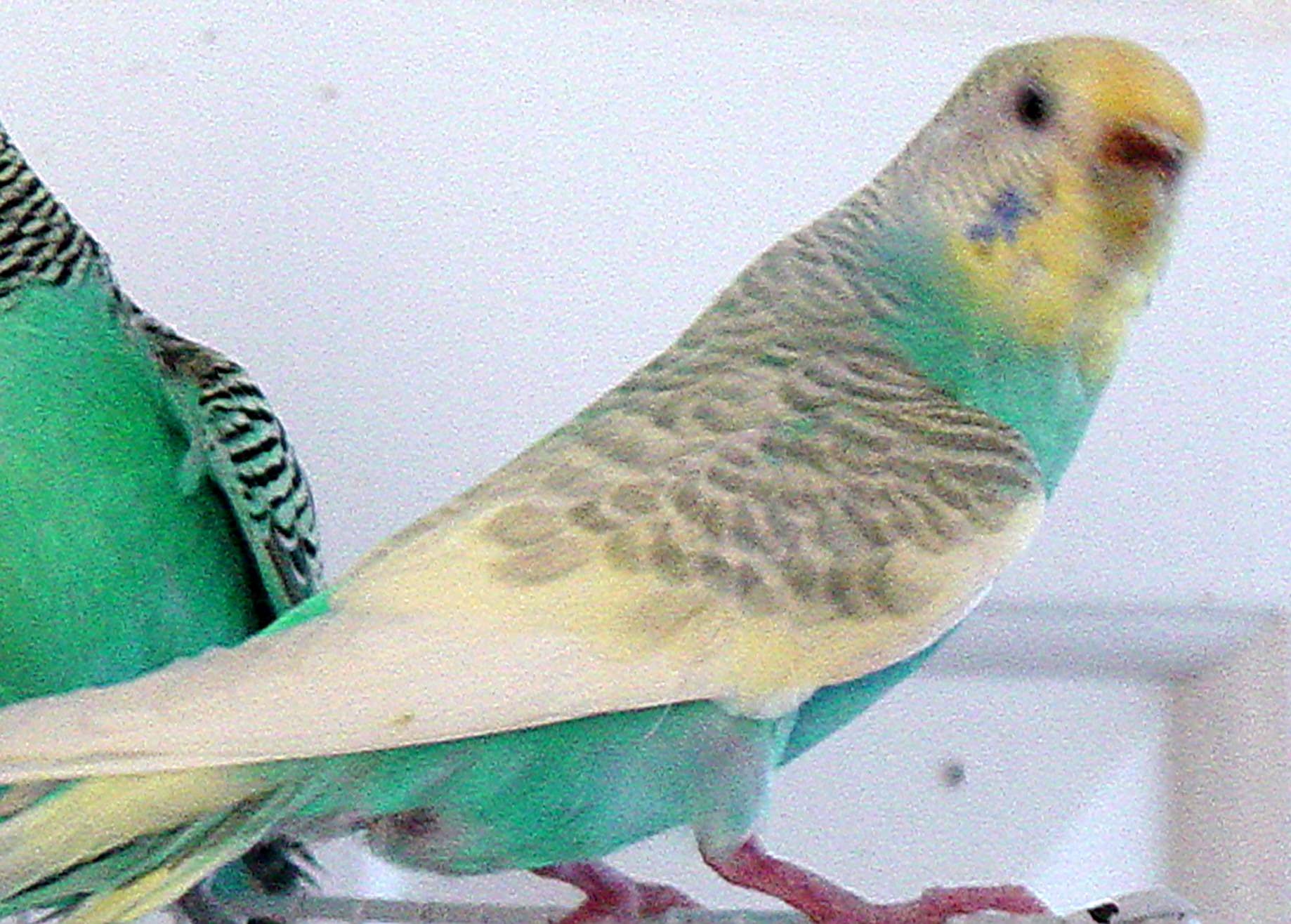
Two normal genes
Bird looks normal: full strength body color, full strength wing marking color
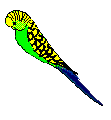
One normal gene, plus one of any of the others.
Bird looks normal: full strength body color, full strength wing marking color

Two greywing genes
Bird looks greywing: faded body color, grey wing markings
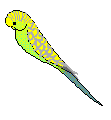
One greywing gene, plus one whitewing gene.
Full body color greywing: full strength body color, grey wing markings
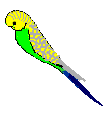
One greywing gene, plus one dilute gene.
Bird looks greywing: faded body color, grey wing markings

Two whitewing genes.
Bird looks whitewing: full strength body color, almost no wing markings.
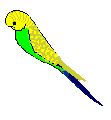
One whitewing gene plus one dilute gene.
Bird looks whitewing: full strength body color, almost no wing markings.

Two dilute genes.
Bird look dilute: very faint body color, very faint wing markings
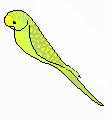

![]() Get your own Free Home Page
Get your own Free Home Page